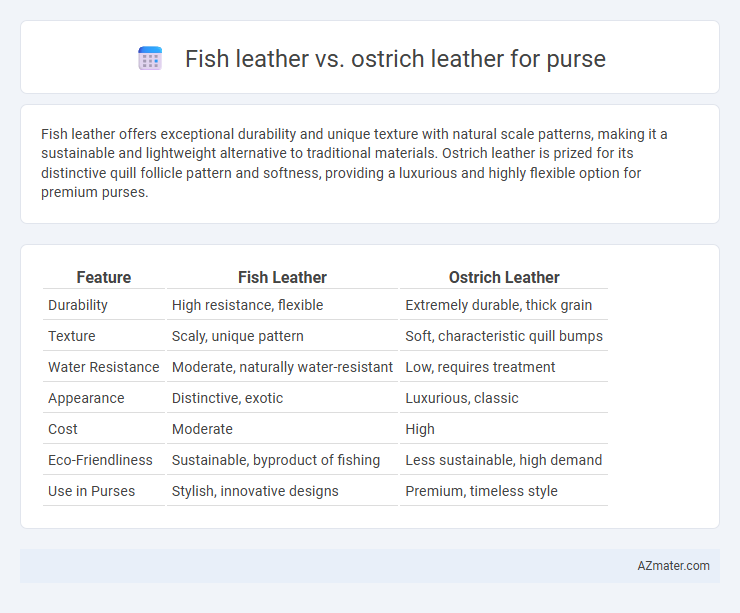Fish leather offers exceptional durability and unique texture with natural scale patterns, making it a sustainable and lightweight alternative to traditional materials. Ostrich leather is prized for its distinctive quill follicle pattern and softness, providing a luxurious and highly flexible option for premium purses.
Table of Comparison
| Feature | Fish Leather | Ostrich Leather |
|---|---|---|
| Durability | High resistance, flexible | Extremely durable, thick grain |
| Texture | Scaly, unique pattern | Soft, characteristic quill bumps |
| Water Resistance | Moderate, naturally water-resistant | Low, requires treatment |
| Appearance | Distinctive, exotic | Luxurious, classic |
| Cost | Moderate | High |
| Eco-Friendliness | Sustainable, byproduct of fishing | Less sustainable, high demand |
| Use in Purses | Stylish, innovative designs | Premium, timeless style |
Introduction: Comparing Fish Leather and Ostrich Leather
Fish leather offers exceptional durability and a unique textured pattern due to its dense fiber structure, making it an innovative choice for purse materials. Ostrich leather is prized for its distinctive quill follicle pattern and softness, providing a luxurious and flexible feel favored in high-end purses. Both materials exhibit strong water resistance and longevity, but fish leather is often more sustainable due to its use of byproducts from the fishing industry.
Origins and Sources of Fish and Ostrich Leather
Fish leather originates primarily from sustainable aquaculture industries, utilizing by-products such as salmon, cod, and perch skins predominantly sourced from Nordic countries and Canada. Ostrich leather is derived from the hides of farm-raised ostriches, with South Africa recognized as the leading supplier due to its vast ostrich farming operations. Both leathers exemplify high-quality exotic materials, but their distinct origins--marine versus avian--affect their texture, durability, and environmental impact in purse production.
Unique Characteristics of Fish Leather
Fish leather offers a unique texture with fine, natural scale patterns that provide exceptional durability and flexibility for purses. Its eco-friendly production from by-products of the fishing industry ensures a sustainable alternative to traditional leathers. The lightweight yet strong material resists water and stains, making it ideal for fashionable, long-lasting purse designs.
Distinct Features of Ostrich Leather
Ostrich leather is known for its unique quill follicle pattern, which creates a distinctive, raised texture that is highly sought after for luxury purses. Its natural oils make the leather exceptionally soft, durable, and resistant to cracking, outperforming fish leather in longevity and flexibility. Fish leather, while eco-friendly and strong, lacks the characteristic aesthetic appeal and supple feel of ostrich leather, making the latter a premium choice for high-end fashion accessories.
Durability and Strength: Fish vs Ostrich Leather
Fish leather, particularly from species like salmon and perch, offers notable durability due to its dense fiber structure, making it resistant to tearing and stretching. Ostrich leather is renowned for its strength and flexibility, featuring a distinctive quill pattern that enhances its toughness while remaining supple for purse construction. Comparing both, fish leather excels in water resistance and unique texture durability, whereas ostrich leather provides superior overall tensile strength and longevity in daily use.
Texture and Appearance Differences
Fish leather features a distinctive, scale-patterned texture that is both lightweight and durable, offering a unique, organic appearance often enhanced by natural glossy finishes. Ostrich leather is renowned for its characteristic quill follicle bumps, providing a pronounced, pebbled texture that exudes luxury and softness with excellent suppleness. The visual contrast is marked by fish leather's sleek, reflective surface compared to ostrich leather's matte, textured look, making each suitable for different fashion aesthetics in purse design.
Sustainability and Environmental Impact
Fish leather, derived from byproducts of the fishing industry, offers a sustainable alternative to traditional leathers by minimizing waste and reducing the need for livestock farming, which lowers greenhouse gas emissions and land use. Ostrich leather, while prized for its durability and unique texture, involves intensive resource consumption, including large amounts of water and feed, contributing to a higher environmental footprint. Choosing fish leather purses supports circular economy principles and promotes environmentally responsible fashion compared to the resource-heavy production of ostrich leather goods.
Price and Market Availability
Fish leather, often sourced from salmon or perch, is generally more affordable than ostrich leather, making it an attractive option for budget-conscious consumers. Ostrich leather commands a higher price due to its durability, unique texture, and limited supply, impacting overall market availability and exclusivity. Fish leather is becoming increasingly popular in niche markets but remains less prevalent than the widely recognized and readily available ostrich leather in luxury purse collections.
Fashion Trends: Purse Design Possibilities
Fish leather offers unique texture patterns and eco-friendly appeal, making it a trendy alternative for innovative purse designs that emphasize sustainability. Ostrich leather is renowned for its distinctive quill follicle pattern, combining luxury with durability, often favored in high-end fashion for sophisticated and exotic-looking purses. Both materials enable designers to explore diverse aesthetics, from bold statement pieces with fish leather's scalability to timeless elegance through ostrich leather's refined texture.
Choosing the Best Leather for Your Purse
Fish leather offers exceptional durability and a distinct scale pattern that enhances purse aesthetics while being eco-friendly due to its sustainable sourcing. Ostrich leather is known for its unique quill follicle texture, softness, and high flexibility, making it a luxurious option for high-end purses. When choosing the best leather for your purse, consider factors such as texture preference, durability requirements, and environmental impact to select between the exotic appeal of fish leather and the premium softness of ostrich leather.

Infographic: Fish leather vs Ostrich leather for Purse
 azmater.com
azmater.com